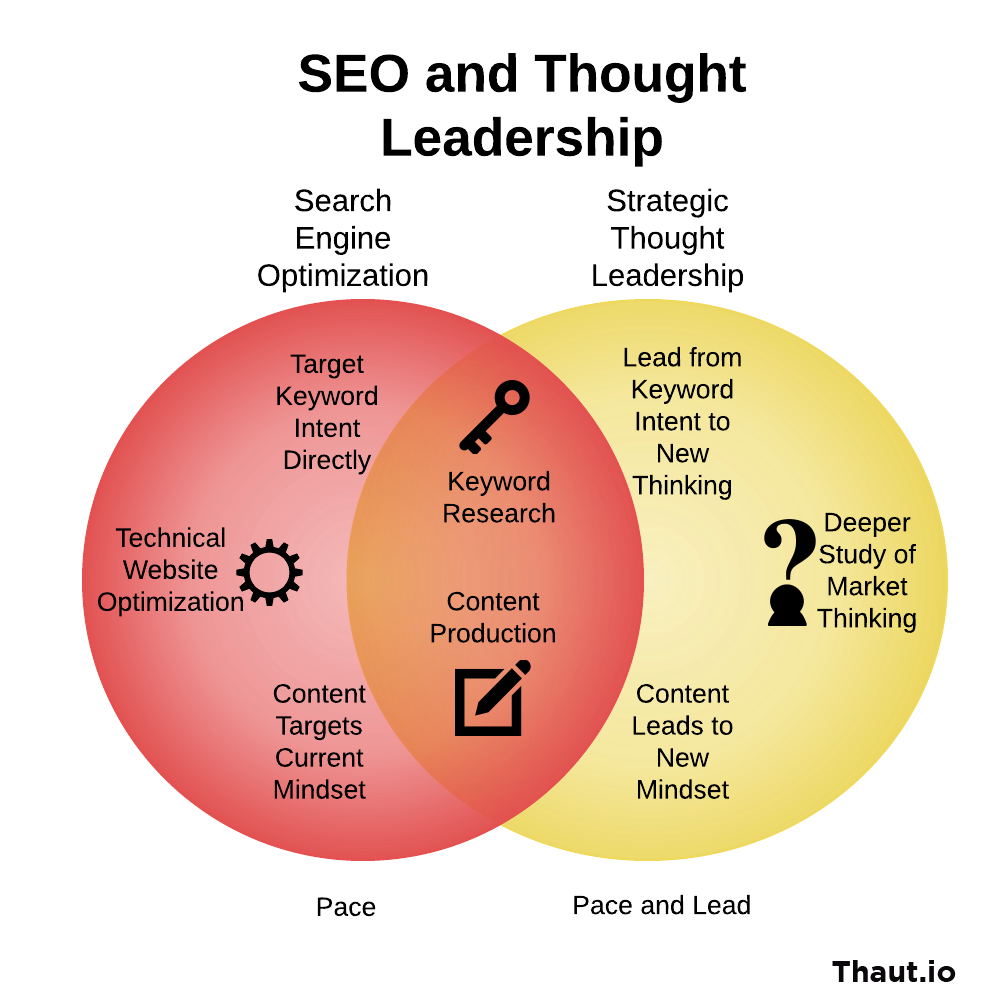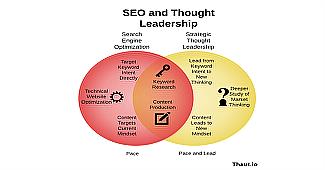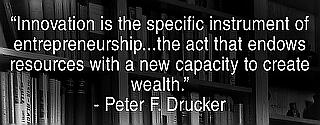What is SEO AKA Search Engine Optimization?
If you are an SEO-savvy marketer, feel free to click here to jump further down and skip the beginner introduction. Search Engine Optimization has the wrong name. It gives many people the impression that it's just something tech people do to magically make a website rank higher on a certain search.
It really should be called search optimization because, while you do have to handle the technical side of making a website search friendly (1), the more important job is matching up with the intentions of the searchers: give them what they are looking for.
We aren't optimizing the engine as much as serving those searching.
So, Dear Business Leader, SEO isn't just technical, it's more about engaging potential customers with the best possible source of the learning they seek. You are aiming to offer the most right answer to the question in the mind of the searcher. And our companies' web presence is all the vast majority of people know about our companies. How can we afford as business leaders to not fully engage in creating the best face forward possible?
Follow along a bit and we'll zoom in closer on the implications and opportunities of aiming for that most right answer to get more traffic, leads, and sales with your content through strategic thought leadership enhancing SEO.
Yes, we all need SEO
Search Engine Optimization (SEO) is still considered essential to maximizing website traffic. With over a Trillion Searches per year (yes, with a "T"), no company can afford to overlook optimizing for the worlds' habit of using Google, DuckDuckGo, Bing, and other search engines to find the answers to their questions about what to buy.
SEO Needs Thought Leadership Integrated for Maximum Effect
Yet, SEO without Thought Leadership is like a photograph of a sculpture compared to the sculpture itself. Without the added dimension, it misses depth. It's not about bettering your competition at optimizing for the obvious searches, it's about how many new types of search traffic, leads and customers you can develop by not just matching those search intentions, but also by:
- First pacing them by closely matching the search terms with content,
- Then leading them from there to somewhere new: a unique thought leadership position.
That pace-and-lead thinking- a common NLP phrase that also applies to strategic thought leadership- shifts the dynamics of SEO in 2 key areas: keyword research and content production. First, we'll examine:
Keyword Research
Keyword research typically involves finding the best searches for a website to rank for. Criteria usually include search volume and level of competition as well as how well the phrasing matches how a typical customer would describe your offering.
That's a limited view.
The practitioner of strategic thought leadership would want to expand that perspective. If you look at the bigger picture, only tapping into the existing demand of the obvious keywords - and satisfying those as expected - leaves your company looking like all the rest and second tier, as opposed to being seen as a leader.
So, you can bend things in 2 directions:
- What search terms that wouldn't normally be associated with your product or service could be led to your offering with thought leadership?
- What unexpected new thinking can you lead the typical searchers - who find your page with the typical keywords - to?
I realize thinking about thinking isn't very grounded, so let's jump right into some real-life examples to make this tangible:
In the first case, consider an airplane maintenance shop. It's full of shining, graceful light aircraft of all sorts in a tall hanger casting long shadows down the airstrip. The owner says "everybody who has a plane around here already knows us." And he seems right. Accordingly, the volume of searches for "airplane mechanics" is very low. But, then, extending further back the timeline of the customer journey, you consider searches looking for "how to get a pilot's license" and discover there are tens of thousands of them a month(!). Nice. So how to extend to those searches through thought leadership?
You can thought-lead by developing a distinctive way of teaching the marketplace that getting a first plane and a pilots license is easier than they may have assumed. It could be something like a 5-Step New Pilot Launch System that sends an avalanche of searches to the site ... and attract a flock of new flyers automatically loyal to the shop that introduced them to the adventure.
It just takes creativity and the willingness to lead.(2)
Or, you could extend the thought leadership vector sideways and ask, "what do people value in flying" and "what other ways are there of satisfying that value?" That could lead to thought-leading content like "10 Ways to Avoid Security Theater in Airports." ... for instance.
The questions that open up the thought leadership opportunities that gain new types of customers first chunk up to more general categories. Such questions can include "what broader categories include our product or service?" and "what do people value about our product or service?" and "What does it really do for them that is important to them?"
Private airplanes fit in the broader categories of ways to travel, ways to get to a destination more quickly, fun things to do when you have more leisure time after retirement, ways to avoid having to go through commercial flight airport checkpoints, and more. These all suggest new sets of keywords that would require thought leadership to lead people to see how what you offer is a great way to satisfy what's important to them.(3)
Now, for the second case, that of matching the intention of searchers already looking for what you do and then leading them somewhere new...
The same airplane shop might start developing new ways to enjoy flying and develop their own proprietary philosophy around that. After all, flying a small plane is fun and leads to phenomena like the "$100 hamburger", a game my old motorcycling buddy who was also a pilot told me about (speed freaks apparently are agnostic about whether they move fast on the ground or in the air) ... the knowledge that there's a local hamburger joint many counties away that is renowned for their grill mastery and just so happens to be right next to an airstrip is a good excuse to fly, indeed.
I hope these examples are triggering your imagination to envision outwards and sideways vectors of thought leadership that can extend the keyword universe of whatever website you want to drive more traffic to.
Whatever your new ideas about extending your keywords with thought leadership are, all roads (or airstrips) lead to the need to know how to do that with content. Which brings us to the second key area:
Content Production
As you have probably surmised from my describing how to expand a site's target keyword list, you do that by leading thinking somewhere new with thought leadership content.
If there's no surprise in the cereal box, why would a kid want to dig inside and rip that wrapper apart?
Even if you are optimizing for the same search terms as the others, take them from there to somewhere else, just for fun ... If you sell "springs" and you need to optimize for that keyword "springs", for goodness' sake, go to the trouble of teaching people who land on your site something new about springs, something cool and only yours they wouldn't have known otherwise. You can teach them:
- How to get the most out of your spring, with our proprietary method.
- Our 23 point program for choosing just the right spring
- Springs aren't just for springing, you can also use them for (fill in the blank)
And it goes on.
The thought leadership marketer helps identify and unpack the distinctive thinking within the best minds in a business that can be turned into market-leading models of thought, then organizes it for impact. Nearly every business leader who has been at it for a while has developed unique ways of thinking that can help customers make smarter buying decisions and get more value out of using what they sell.
But these leaders rarely know how to organize, package and codify that thinking in a way that is attractive to the marketplace and can literally build a movement so an audience grows that wouldn't consider doing business with anyone else in their category. That process is the job of the Thought Leadership Marketer.
Are you learning yet that thought leadership marketing can be fun? You get to access your creative side and invent the new. Creativity is intrinsically enjoyable. Guitarists play not for the money but for the playing. Play with your thought leadership marketing.
Have fun, create the new, lead people somewhere they like, expand your audiences, and take your search results with SEO up a few notches while you're at it.
Written by Chris McNeil
Founder of Thaut and 5th Level Web
(1) By also speaking the language of the metaphorically named spiders that crawl the web indexing pages for search engines to display in search results
(2) And, research in the form of multi-level audience listening research like Thaut offers.
(3) And they all imply more of the audience listening as mentioned in 2 above. That can reveal the best opportunities for thought leadership that satisfy your growing audience's values in distinctive ways with the new ways of thinking you can lead them to.

10 Reasons Your 2025 Content Marketing Strategy Needs Strategic Thought Leadership
Strategic Thought Leadership offers a robust Content Marketing Strategy that can move the mind of a marketplace.

2 Key Areas Where Thought Leadership Enhances SEO
Thought Leadership Marketing can boost SEO with new audiences adding new keywords thus more traffic as well as better search results through enhanced engagement metrics. And the high authority content naturally attracts inbound links as a bonus.

Information is Not Insight
What happens when we take our marketing technology to the customer point of view?

The LEO Model of Thought Leadership
With Thauts on making movies, theme parks, creativity, and Walt Disney's Imagineering... and how they apply to marketing

Marketing Tech-2022 - 3 Trends Shaping Marketing AI
Three trends are shaping how Artificial Intelligence is perceived and used in marketing. More responsiveness to the end customer and a role for AI that better supports human creativity will result.

infographic 8 Reasons Why Your Marketing Needs Thought Leadership
8 Reasons Why Your Marketing Needs it: Lock in Loyalty, Avoid being a Commodity, Market with Respect, Fulfillment of Creative Leadership, Be a Liberator, Escape the Design Trap, Demonstrate Excellence, Enhance SEO

Easy 4 Ingredient Recipe to Staying in the Zone
The flow state, sometimes known as the "zone," is a state of peak performance treasured by athletes, artists, and high performing businesspeople. Fields like Sports Psychology and NLP study this “peak performance” state in order to help people create it more consistently and utilize it for higher achievement

Thought Leadership FAQs
FAQs about Thought Leadership

43 Innovation Quotes to Inspire Your Next Idea
“Innovation is the specific instrument of entrepreneurship...the act that endows resources with a new capacity to create wealth.” - Peter F. Drucker

The 6 Levels of the Aligned Team
Introduction to The 6 Levels of the Aligned Team - Creating a Congruent Peak Performance Company

5 Powerful Applications for NLP in Business
Do you value excellence in business? One definition of NLP (Neuro Linguistic Programming) is the study and replication of excellence. As such, it has many applications in the business arena.

Five Levels Up to an Experience Centered Company
When I opened my first iPhone box, I was delighted. Here was a package that didn't require a knife or scissors to rip apart. Instead, it demonstrated deeper levels of thoughtful design by gently unfolding to a neatly designed interior. The shapes pleased my eyes.

4 Ways to Get Focus in the Age of Distraction
In today's world, the ability to consciously create focus is a tremendous strategic advantage. If you master that, you are a shark amongst minnows, a crocodile amongst turtles.

The 5 Reasons I Started a Mastermind
Sometimes, incremental progress will do the trick. Other times, only a breakthrough will do.

Two Ways to Market from Glass Houses
We are Marketing from Glass Houses




